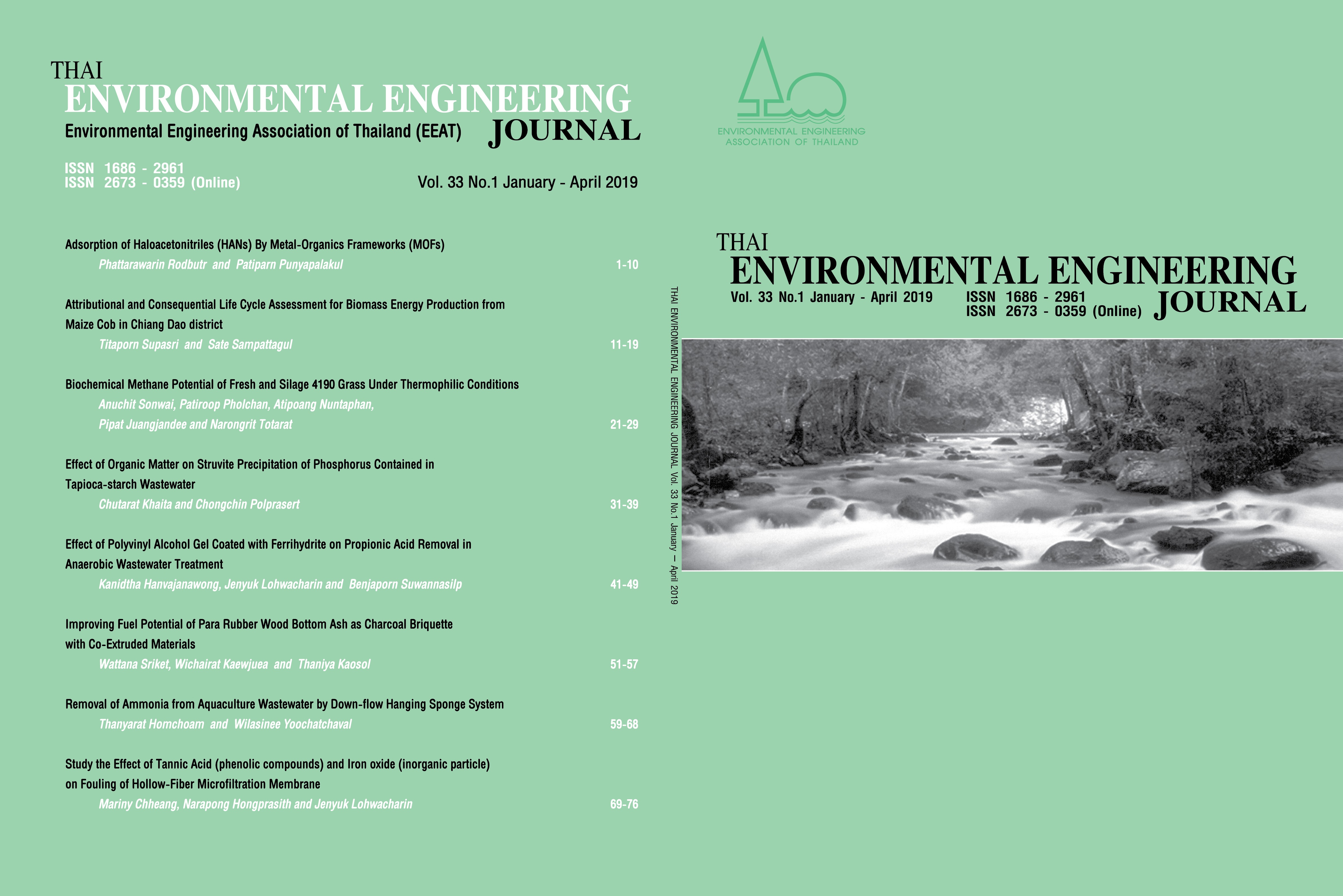Attributional and Consequential Life Cycle Assessment for Biomass Energy Production from Maize Cob in Chiang Dao district
Main Article Content
Abstract
Maize is one of the most typical crops cultivated in Chiang Mai, Thailand. According to Office of Agricultural Economics, maize production in Chiang Mai in 2016 was about 121,665 tonne while the maize residues (cobs, leaves, and stalks) was around 253,063 tonne. In Chiang Dao, one of district in Chiang Mai, the production of maize and maize residues were 17,905 and 37,242 tonne, respectively. Maize farming in Northern of Thailand is growing tremendously. However, the current maize farming practices have also caused several problems to local communities as well as urban dwellers. Therefore, improper agricultural practices have contributed to negative environmental impacts. This study evaluates the life cycle environmental impacts of biomass energy production from maize cob in Chiang Dao district by using Attributional Life Cycle Assessment (ALCA) and Consequential (CLCA) approaches. The system boundary of this study includes land preparation, planting, weeding, farming, harvesting, maize cob pellet production and heat production from maize cob pellet. The functional unit of this study is 1 MJ of biomass energy production from maize cob. The data were obtained from field survey supplemented with Thai National Life Cycle Inventory Database and scientific publication. The product systems being effected under global and national markets depend on the market delimitation of each product. The additional maize cob production dedicating specifically for biomass energy production from maize cob potentially contributes to substantial environmental impacts reductions and biomass fully utilization. Furthermore, this research presents how modelling choices affect the environmental impacts of biomass energy production from maize cob.
Article Details
References
[2] Kim, S., Dale, B. E. and Jenkins, R. 2009. Life cycle assessment of corn grain and corn stover in the United States. Int. J. Life Cycle Ass. 14(2): 160-174. ISSN 0948-3349.
[3] Luo, L. et al. 2009. Allocation issues in LCA methodology: a case study of corn stover-based fuel ethanol. Int. J. Life Cycle Ass. 14(6): 529-539. ISSN 0948-3349.
[4] Cherubini, F. and Ulgiati, S. 2010. Crop residues as raw materials for biorefinery systems–A LCA case study. Appl. Energ. 87(1): 47-57. ISSN 0306-2619.
[5] Kaliyan, N., Morey, R. V. and Tiffany, D. G. 2011. Reducing life cycle greenhouse gas emissions of corn ethanol by integrating biomass to produce heat and power at ethanol plants. Biomass Bioenerg. 35(3): 1103-1113. ISSN 0961-9534.
[6] Bacenetti, J. et al. 2013. Life Cycle Assessment of maize cultivation for biogas production. Journal of Agricultural Engineering. 44(2). ISSN 2239-6268.
[7] Batidzirai, B. et al. 2016. Current and future technical, economic and environmental feasibility of maize and wheat residues supply for biomass energy application: Illustrated for South Africa. Biomass Bioenerg. 92: 106-129. ISSN 0961-9534.
[8] Thomassen, M. A. et al. 2008. Attributional and consequential LCA of milk production. Int. J. Life Cycle Ass. 13(4): 339-349. ISSN 0948-3349.
[9] Schmidt, J. H. 2008. System delimitation in agricultural consequential LCA. Int. J. Life Cycle Ass. 13(4): 350. ISSN 0948-3349.
[10] Nguyen, T. T. H. et al. 2013. Consequential LCA of switching from maize silage-based to grass-based dairy systems. Int. J. Life Cycle Ass. 18(8): 1470-1484. ISSN 0948-3349.
[11] Escobar, N. et al. 2014. Consequential LCA of two alternative systems for biodiesel consumption in Spain, considering uncertainty. J. Clean. Prod. 79: 61-73. ISSN 0959-6526.
[12] Schmidt, J. H. 2015. Life cycle assessment of five vegetable oils. J. Clean. Prod. 87: 130-138. ISSN 0959-6526.
[13] Prapaspongsa, T. and Gheewala, S. H. 2016. Risks of indirect land use impacts and greenhouse gas consequences: an assessment of Thailand's bioethanol policy. J. Clean. Prod. 134: 563-573. ISSN 0959-6526.
[14] Garrian, D., De La Rua, C. and Lechon, Y. 2016. Consequential effects of increased biofuel demand in Spain: Global crop area and CO2 emissions from indirect land use change. Biomass Bioenerg. 85: 187-197. ISSN 0961-9534.
[15] Prapaspongsa, T. and Gheewala, S. H. 2017. Consequential and attributional environmental assessment of biofuels: implications of modelling choices on climate change mitigation strategies. Int. J. Life Cycle Ass. 22(11): 1644-1657. ISSN 0948-3349.
[16] Prapaspongsa, T., Musikavong, C. and Gheewala, S. H. 2017. Life cycle assessment of palm biodiesel production in Thailand: impacts from modelling choices, co-product utilisation, improvement technologies, and land use change. J. Clean. Prod. 153: 435-447. ISSN 0959-6526.
[17] Weidema, B. P. et al. 2018. Attributional or consequential Life Cycle Assessment: A matter of social responsibility. J. Clean. Prod. 174: 305-314. ISSN 0959-6526.
[18] ISO (International Organization for Standardization), 2006a. Environmental Management Life Cycle Assessment- Principles and Framework. ISO 14040.
[19] ISO (International Organization for Standardization), 2006b. Environmental Management Life Cycle Assessment-Requirements and Guidelines. ISO 14044.
[20] Sonnemann, G. and Vigon, B. 2011. Global guidance principles for Life Cycle Assessment (LCA) databases: a basis for greener processes and products. ISSN 9280731742.
[21] DEDE, 2015. The Alternative Energy Development Plan (AEDP): 2015 (In Thai). Department of Alternative Energy Development and Efficiency (DEDE), Ministry of Energy, Thailand. http://www.dede.go.th/download/files/AEDP2015_Final_ version.pdf (accessed May 2018).


